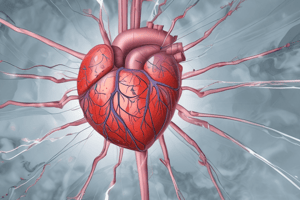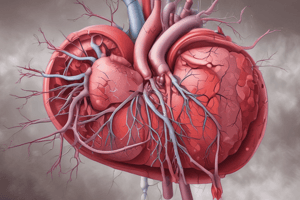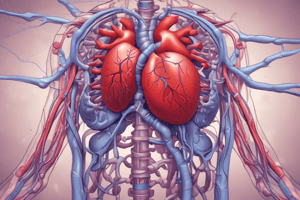Podcast
Questions and Answers
Which of the following statements about pulmonary embolism is correct?
Which of the following statements about pulmonary embolism is correct?
- Pulmonary embolism is caused by a blood clot that travels to the lungs. (correct)
- Pulmonary embolism occurs primarily due to infections in the lungs.
- Pulmonary embolism can only occur in individuals over the age of 60.
- Pulmonary embolism is unrelated to deep vein thrombosis.
What is a common cause of pulmonary embolism?
What is a common cause of pulmonary embolism?
- Deep vein thrombosis (correct)
- Respiratory infection
- Pneumonia
- Chronic obstructive pulmonary disease
What is the primary treatment option for preventing further clotting in pulmonary embolism?
What is the primary treatment option for preventing further clotting in pulmonary embolism?
- Surgery
- Anticoagulants (correct)
- Hydration
- Compression stockings
Which symptom is commonly associated with pulmonary embolism and may worsen with exertion?
Which symptom is commonly associated with pulmonary embolism and may worsen with exertion?
Which of the following conditions can lead to the presence of fat embolism?
Which of the following conditions can lead to the presence of fat embolism?
What is a preventive strategy recommended for high-risk patients after surgery?
What is a preventive strategy recommended for high-risk patients after surgery?
Which of the following symptoms might indicate pulmonary embolism and is characterized by rapid heart rate?
Which of the following symptoms might indicate pulmonary embolism and is characterized by rapid heart rate?
What method may be utilized to catch blood clots before they reach the lungs?
What method may be utilized to catch blood clots before they reach the lungs?
Which approach is least likely to assist in preventing thrombosis during long periods of immobility?
Which approach is least likely to assist in preventing thrombosis during long periods of immobility?
What is a rare condition during childbirth that can lead to pulmonary embolism?
What is a rare condition during childbirth that can lead to pulmonary embolism?
Flashcards are hidden until you start studying
Study Notes
Causes of Pulmonary Embolism
- Deep Vein Thrombosis (DVT) is the primary cause, involving blood clots forming in deep veins, often in the legs, that can migrate to the lungs.
- Air Embolism occurs when air bubbles enter the bloodstream, typically due to trauma or medical procedures.
- Fat Embolism results from fat globules entering circulation, usually following fractures or orthopedic surgeries.
- Amniotic Fluid Embolism is a rare occurrence during childbirth where amniotic fluid enters the mother's bloodstream.
- Certain tumors, particularly from cancers, can induce blood clot formation leading to pulmonary embolism.
Symptoms of Pulmonary Embolism
- Sudden shortness of breath that may worsen with physical activity is a key indicator.
- Chest pain can manifest as sharp or stabbing and is usually exacerbated by deep breathing.
- Coughing may occur, potentially producing blood-streaked sputum.
- Rapid heart rate (tachycardia) is common due to decreased oxygen levels in the bloodstream.
- Dizziness or lightheadedness may be experienced, especially during exertion or when standing up quickly.
Treatment Options for Pulmonary Embolism
- Anticoagulants, including heparin or warfarin, are administered to prevent further clotting.
- Thrombolytics, known as "clot busters," may be rapidly administered in severe cases to dissolve clots.
- An Inferior Vena Cava (IVC) Filter can be implanted to catch clots before they reach the lungs.
- Surgical options, such as embolectomy, are considered when clot removal is necessary.
- Supportive care focuses on oxygen therapy and pain relief to alleviate symptoms.
Prevention Strategies for Pulmonary Embolism
- Encouraging mobility and leg exercises is vital during prolonged periods of immobility, such as long flights or bed rest.
- Using graduated compression stockings can promote better blood flow in the legs.
- Staying adequately hydrated is important to prevent blood thickening.
- Anticoagulant prophylaxis is recommended for high-risk patients, including those recovering from surgery or with a history of DVT.
- Adopting lifestyle changes, such as achieving a healthy weight, quitting smoking, and managing chronic conditions like heart disease, is essential to lessen risk factors.
Studying That Suits You
Use AI to generate personalized quizzes and flashcards to suit your learning preferences.



